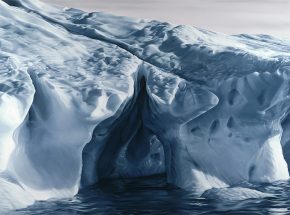

As the largest cutter in the U.S. Coast Guard fleet, the Coast Guard Cutter Healy is amply suited for double duty as an icebreaker and as a research vessel that carries laboratories and accommodations for up to 50 scientists and civilian support staff. I deployed aboard the Healy in August of 2013 to observe a survey of the southern reaches of the Arctic Ocean, known as the Chukchi Sea. Sponsored by the Bureau of Ocean Energy Management and the National Science Foundation, the mission was to gather data that would help to lay an environmental base line in anticipation of the first proposed oil drilling in the region.
Under the auspices of COGAP, the U.S. Coast Guard Art Program, my assignment was to capture the work of the Coast Guard and especially Coast Guard personnel as they supported Arctic research. Finding a definitive image that would express my theme had proven to be challenging, however, until an opportune moment presented itself late in the voyage. After weeks of putting large-scale apparatus over the side, some of the scientists wanted to complete their work by chipping samples from an ice floe and requested that the ship put down a small boat. It was my chance. When the captain agreed to my request for a second craft, I was on my way out to the ice to follow the action.
On that day, lead gray skies had yielded only adequate visibility for the operation. The temperature, typical for high summer in the southern Arctic, hovered at the freezing point turning precipitation that might have been snow to a soaking drizzle. I had hoped to see the Healy in the background as I watched the other boat maneuver among the floes, but overhanging ice blocked my view. Even so, I was lucky. My coxswain positioned me at the perfect angle at the very moment that a scientist thrust himself across the gunwale and literally reached into the sea. It was a striking sight made even more remarkable by a second scientist who happened to be assisting with a pole. From my angle, the second man’s pose put me in mind of Leutze’s famous painting of George Washington crossing the Delaware.
For the final composition, I chose to couple the scene I had witnessed with a view of the icebreaker standing off in the distance as seen from my extraordinary vantage point. On the floor of that boat I was literally inches from the Arctic Ocean. I was beyond great ships and cranes; close enough to see humans cooperating with humans in the pursuit of knowledge.
Some weeks later, I returned to my studio determined to capture that scene and the important work that it reflected.
Robert Selby
